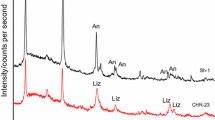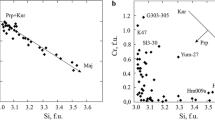Abstract
Serpentine- and talc-like garnierites described in Parts I and II were heated at various temperatures up to about 1000°C and after each treatment were cooled and examined by X-ray powder diffraction. The serpentine-like garnierites at about 550°C, the temperature at which rapid dehydroxy-lation begins, formed a highly disordered phase. When the NiO content was low (approximately < 20 wt%), the disordered phase transformed directly to an olivine phase around 800°C, but when the NiO content was higher, various transitional phases were formed before an olivine phase appeared around 1000°C. A sepiolite-like phase was obtained with one sample around 800°C, and several samples showed face-centered cubic modifications between 900 and 1000°C.
The talc-like garnierites with low NiO content formed an enstatite phase around 800°C directly following the dehydroxylation reaction, but with high NiO contents an olivine phase became increasingly prominent between 850 and 1000°C.
Identification of the mixed crystallizations possibly existing in the initial minerals is scarcely feasible on the basis of the products formed up to 1000°C.
Résumé
Les garniérites du type talc et serpentine décrites dans les parties I et II ont été chauffées à différentes températures jusqu’à 1000°C environ, et après chaque traitement ont été refroidies et examinées en diffraction X par diagramme de poudre. Les garniérites du type serpentine forment une phase hautement désordonnée à 550°C, température à laquelle une déshydroxylation rapide commence. Pour de basses teneurs en NiO (environ moins de 20 pour cent en poids) la phase désordonnée se transforme directement en une phase olivine autour de 800°C, mais, pour des teneurs en NiO plus élevées, diverses phases de transition se forment avant que n’apparaisse vers 1000°C une phase olivine. Une phase du type sépiolite a été obtenue avec un échantillon vers 800°C, et plusieurs échantillons ont montré des modifications du type cubique face centrée entre 900 et 1000°C.
Les garniérites du type talc avec de basses teneurs en NiO donnent une phase enstatite vers 800°C, qui suit immédiatement la réaction de déshydroxylation, mais pour les fortes teneurs en NiO, une phase olivine devient de plus en plus importante entre 850 et 1000°C. L’identification de cristallisations mixtes existant éventuellement dans les minéraux de départ est très difficile à faire sur la base des produits formés en chauffant jusqu’à 1000°C.
Kurzreferat
Die in den Teilen 1 und 2 beschriebenen serpentin- und talkartigen Garnieriten wurden auf verschiedene Temperaturen bis etwa 1000°C erhitzt und nach jeder Behandlung abgekühlt und in pulverförmigem Zustand nach dem Röntgenbeugungsverfahren untersucht. Die serpentinartigen Garnieriten bildeten bei etwa 550°C, wenn schnelle Dehydroxylation einsetzt, eine außerordentlich unregelmäßige Phase. Wenn der Gehalt an NiO gering war (etwa 20 Gew.-per cent) verwandelte sich diese Phase bei einer Temperatur von etwa 800°C unmittelbar in eine Olivinphase, doch bei höherem NiO Gehalt entstanden verschiedene Übergangsphasen, bevor bei etwa 1000°C eine Olivinphase auftrat. Bei einer Probe wurde im Bereich von 800°C eine sepiolitartige Phase erzielt, und mehrere Proben wiesen zwischen 900° und 1000°C würfelige Modifikationen an der Oberfläche auf.
Die talkartigen Garnieriten mit geringem NiO Gehalt bildeten eine Enstatitphase im Bereiche von 800°C unmittelbar nach der Dehydroxylationsreaktion, doch bei hohem NiO Gehalt trat zwischen 850° und 1000°C in immer höherem Baße eine Olivinphase in Erscheinung. Identifizierung der gemischten Kristallformen, die in den Ausgangsmineralien bestehen mögen, ist aufgrund der bis 1000°C gebildeten Produkte kaum durchführbar.
Резюме
Серпентино- и талькообразные гарниериты, описанные в частях I и II нагревались при различных температурах приблизительно до 1000°С и после каждой переработки охлаждались и исследовались рентгеновской дифракцией на порошке. При нагреве до 550°С, когда начинается быстрая гидроксиляция серпентинообразные гарниериты образовали очень беспорядочную фазу. При низком содержании NiO (приблизительно 20 вес %), беспорядочная фаза после нагрева до 800°С приблизительно менялась непосредственно в оливиновую фазу, но когда содержание NiO было более высоким, перед появлением оливиновой фазы при нагревании до 1000°С приблизительно формовались различные переходные фазы. С одной пробой получили сепиолитообразную фазу при нагреве до 800°С приблизительно, а на разных образцах заметили кубические изменения к центру поверхности при 900°-1000°С.
Талькообразные гарниериты с низким содержанием NiO формируют энстатитную фазу при 800°С приблизительно непосредственно после реакции дегидроксиляции, но при высоком содержании NiO оливиновая фаза становится более заметной при нагревании до 850°-1000°С. Идентификация смешанной кристаллизации, по всей вероятности, существующей в исходных минералах почти что невозможна на основании продуктов формующихся при нагревании до 1000°С.
Similar content being viewed by others
References
Brindley, G. W. and Hayami, R. (1964) Kinetics and mechanisms of dehydration and recrystallization of serpentine —I and II: Clays and Clay Minerals 12, 35–54.
Brindley, G. W. and Hayami, R. (1965) Mechanism of formation of forsterite and enstatite from serpentine: Mineral. Mag. 35, 189–195.
Brindley, G. W. and Zussman, J. (1957) Structural study of the thermal transformation of serpentine minerals to forsterite: Am. Mineral. 42, 461–474.
Campbell, F. E. and Roeder, P. (1968) The stability of olivine and pyroxene in the Ni-Mg-Si-O system: Am. Mineral. 53, 257–268.
Hill, R. D. (1955) 14 Å spacings in kaolin minerals: Acta Cryst. 8, 120.
Hill, R. D. (1956) Studies in rehydrated and refired kaolinite minerals. Trans. Brit. Ceram. Soc. 55, 441–456.
Hotz, P. E. (1964) Nickeliferous latentes in southwestern Oregon and northwestern California. Econ. Geol. 59, 355–396.
Nelson, B. W. and Roy, R. (1954) New data on the composition and identification of chlorites: Clays and Clay Minerals 2, 335–348.
Roy, R. and Brindley, G. W. (1956) Hydrothermal reconstitution of the kaolin minerals: Clays and Clay Minerals 4, 125–132.
Vitovskaya, I. V. and Berkhin, S. I. (1968) The problem of the nature of kerolite: Kora Vyvetrivaniya 10, 134–159.
Vitovskaya, I. V. and Berkhin, S. I. (1970) The nature of garnierite. Kora Vyvetrivaniya 11, 26–39.
Author information
Authors and Affiliations
Rights and permissions
About this article
Cite this article
Hang, P.T., Brindley, G.W. The Nature of Garnierites—III Thermal Transformations. Clays Clay Miner. 21, 51–57 (1973). https://doi.org/10.1346/CCMN.1973.0210108
Received:
Published:
Issue Date:
DOI: https://doi.org/10.1346/CCMN.1973.0210108




